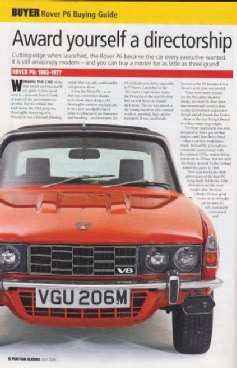 Rover P6: 1963-1977 Models :- Series 1 2000 & 3500, Series 2 2000, 2200 & 3500
Rover P6: 1963-1977 Models :- Series 1 2000 & 3500, Series 2 2000, 2200 & 3500
Price check: Record Price : £23,000 , Mint: £3000-£15,000, Average: £1400-£4500, Rough: scrap value £0 - £1400.
Cutting edge when launched, the Rover P6 is still amazingly modern – and you can buy a very nice car for just three grand
Winning the Car of the Year award isn’t necessarily any guide to how good a car really is – you only have to look at some of the past winners to see that. But the vehicle that took home the 1964 gong was thoroughly deserving of it, because it was a forward-thinking model that was safe, comfortable and great to drive. It was the Rover P6 – a car that was a revelation thanks to its clean-sheet design and thoroughly modern mechanicals. It set a new standard when it came to refinement, performance and handling – and even now the P6 is fabulous to drive, especially in V8 form. Launched at the 1963 Earls Court motor show, the P6 replaced the staid P4 that had earned Rover its ‘Auntie’ nickname. The car was aimed at the young executive who wanted modern, sporting, high quality transport, and it was unofficially known as the P6 because it was Rover’s sixth post-war model. There were many reasons for the P6’s ultra-modern image, not least of all its clean lines, unconventional construction, racing-derived rear suspension design and all-round disc brakes – those at the rear being in-board to reduce unsprung weight. The front suspension was even designed so that a gas turbine engine could have been fitted – what a car that would have made! Instead the powerplants remained conventional, with the original 1978cc engine being bored out to 2204cc, but not until after the fabulous Buick-derived 3528cc V8 had joined the party in 1968.Next year marks the 30th anniversary of the final P6 being built, and as with so many classics, it’s ridiculously underpriced. While the 3500 derivatives are the most sought after, it’s perfectly possible to use a four-cylinder P6 as an everyday car as they’re safe, reasonably economical and comfortable as well as good to drive. Buy yours soon before word gets out!
BODYWORK
The construction of the P6 is quite unlike most other classics that you’re likely to have worked on. The nearest comparison is the Citroen DS, as it also featured a monocoque onto which the unstressed panels were hung. With all the panels being bolted on (including even the roof), it’s easy enough to remove everything and view the stressed ‘skeleton’ in its naked state – although this isn’t something you can ask to do as part of your pre-purchase inspections! That’s a shame, because the monocoque can rot, especially in the centre section – although the P6 is far less rust-prone than most of its contemporaries. It’s essential that you have a good prod underneath with a bradawl, because even fairly major corrosion can easily be masked by the factory-applied underseal.The sills also need careful inspection; they’re crucial to the car’s strength but also rot-prone. Don’t be fooled by outer sill panels that are in perfect condition; these are bolt-on items that are purely cosmetic rather than structural. It’s also important to check the condition of the sills from inside the car; peel back the carpets and have a good poke.Your next port of call is the area under the back seat, so remove it and make sure the metal at either side is still there; it often isn’t. If there’s corrosion here there’s a good chance that the rear wheelarches are rotten, along with the closing panel that the back door shuts onto. You’ll need to inspect the wheelarch lips as well as the rear quarter panels because these are some of the most common corrosion hot spots. It’s a similar story for the leading edge of the rear wings; if these have corroded badly there’s a very good chance that the inner wings will also be full of holes. Even if the wings appear to be okay, have a good look at the rear valance as well as the rear quarter panels; these are quite happy to rot for England. Open the boot lid and see what state the boot floor is in; also see what the panels inside the rear wings are like. The rear suspension trailing arms are bolted to these, which means they’re under a lot of stress. Consequently, once the metal has started to weaken through rust it’s possible for the arms to pull right out.Less serious, but highly likely, is rot in the front wings around the wheelarches and along their trailing edge (just ahead of each front door). While you’re inspecting these, take a look at the undersides of each door; these are more prime targets for the tin worm. It’s just the same for the front valance, which could well be just a memory by now.The bonnet and boot lid won’t have corroded, as they’re made of aluminium. However, because of this the paint may have started to flake off around the washer jets, potentially spreading further afield within the panel. The very last cars were sprayed in the new paint shop set up to finish the SD1, but whereas cars sprayed in the previous plant generally had a decent finish, the paint tended to just fall off these last cars. By now they should all have been attended to though; any paint that hasn’t fallen off yet is unlikely to do so.
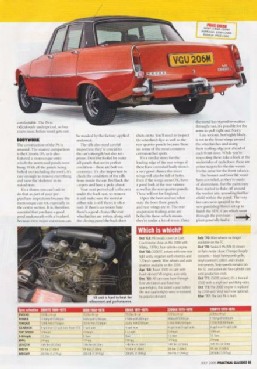
ENGINES
There were two engines fitted to the P6; an overhead cam four-cylinder unit and that classic pushrod V8. The four-pot initially displaced 1978cc, but this rose to 2205cc when the 2200 models replaced the 2000 in 1973. Whichever four-pot was fitted, there was the option of one carburettor or two – and any of these units should happily despatch 100,000 miles before major maintenance is required. Despite the inherent durability of the four-cylinder unit, there are still potential problems to look out for. One of the most common is water leaking from the block’s side cover plates, potentially leading to overheating. Things can be made worse if these plates have rotted through, but used plates are available for £30-40 each. Things aren’t helped by cylinder heads that can corrode internally if the correct anti-freeze levels haven’t been maintained: a 50:50 mix is best. Listen for a rattling timing chain; it’s normal for some clattering at start up, but this should quickly subside. Even when warm there’ll be a hollow ringing sound at around 1200rpm, which then disappears as revs rise; the top chain is straightforward to replace, the bottom one far less so. If a TC-badged car seems to have rather flat performance, it could be that the carburettors are out of balance, but it’s an easy enough job to sort this out. Also, cars with twin carbs are prone to running on and pinking thanks to the rather high 10:1 compression ratio. Where SC engines are concerned, be prepared for wear of the throttle spindles and linkage. If there’s an annoying rattle at high engine speeds it’s likely to be a cracked carburettor heat shield; replacements are £10. If you can hear rattling from inside the inlet manifold, it’s the spacer inside the carb-to-manifold adaptor. It can get into the engine so it’s a good idea to retrieve it!On SC and V8 engines you need to check the exhaust manifold mounting flanges, as these crack; used manifolds are typically £35-50 apiece. The V8 engine is equally durable as long as it’s properly serviced. That means oil changes every 3000 miles; if this hasn’t been done there’s a good chance the hydraulic tappets will have got clogged up and the camshaft, followers and rocker shaft may have worn prematurely too. The giveaway is an especially noisy top end; these units should run very quietly even as the revs rise. Don’t be too concerned by an oil pressure gauge that seems to read lower than you’d expect, as these engines run quite happily with just 15-20psi showing. Of more concern is knocking from the bottom end; this signals that a rebuild is due, for which you can expect to pay £500 for the parts.Chief wear point on the V8 is tappet number eight, which is the first to get noisy due to the small oilways. It’s caused by infrequent oil changes, which should be performed every 3000 miles. Tappet wear is normally an indication of camshaft wear, but fixing it all is straightforward.Oil leaks from pre-1973 V8s are par for the course, as they used rope-type seals for the front and rear bearings. These are ineffective, and replacing them means stripping down the engine. New neoprene front seals are £12 each but upgrading the rear one means machining the block.As well as renewing the oil regularly, it’s essential that the coolant is replaced every couple of years. Being an all-alloy unit, the V8 is prone to internal corrosion if anti-freeze levels are allowed to drop off, so check the temperature gauge once the car has been allowed to idle for a few minutes. If it gets ever hotter, it’s probably because the radiator and block are full of deposits that need to be flushed out.
TRANSMISSION
Whether there’s a four-speed manual or a three-speed automatic gearbox fitted, there shouldn’t be any significant problems – except perhaps where the 3500S is concerned. This was fitted with an uprated version of the manual ‘box fitted to the four-cylinder cars, and it’s not really up to the job of coping with the V8’s torque. Look out for difficult gear selection and jumping out of gear which indicate there’s a £400 bill looming for a rebuilt ‘box. The SD1’s five-speed unit can be fitted – but they’re now getting very hard to find. Automatic cars were initially fitted with a Borg Warner Type 35 gearbox, but from 1974 the Type 65 unit took over on the 3500. This later gearbox is smoother than the earlier unit, but slightly less durable. Whichever unit is fitted, check the state of the transmission fluid (the dipstick is to the left of the engine, near the oil dipstick on BW35 equipped cars, to the right on BW65 models). It should be pink and without any horrific smells attached; if it’s got black specks in it and smells really grim, the gearbox will need a rebuild before long because it’s overheated at some point.The rest of the transmission is conventional, so you need to make sure there are no clonks as you take up the drive. If there are any, it’s because at least one of the six universal joints in the propshaft or driveshafts has worn out. Replacements are £8.50 each for the propshaft and £19 for the driveshafts; renewing them is easy.Gear selection problems and rattly gearsticks on manual cars are usually due to wear in the remote linkage. Pre-1971 cars, with a tortuous linkage, are especially prone. New bushings are available, but fitting them means removing the engine and gearbox. Differentials are long-lived as long as they’re not allowed to run dry. The problem is that they’re prone to leaks, which means there’s a very real chance of seizure. The earliest cars (up to 1967) are even more badly affected because they were fitted with faulty breathers which allowed the casing to pressurise, blowing the seals out – although any such affected units should have been replaced by now.
STEERING & SUSPENSION
The P6’s worm and roller steering box is precise and predictable when set up well, but not as sharp as a rack-and-pinion set-up. Make sure there are no tight spots, indicating that someone has overtightened the box to take out any play. The steering can be heavy, which is why power assistance is desirable. It can be retro-fitted without too much difficulty; expect to pay £300 to convert a V8 and £400 for a four-cylinder car.The front suspension design is equally unusual, in that there are horizontal coil springs which are actuated by bell-crank levers, which transmit their loadings into the bulkhead. Despite its eccentricity, the system is effective and durable. One potential fault is worn ball joints at the bottom of the suspension legs; once they’re in need of replacement there’ll be an obvious clonk on uneven surfaces.The rear suspension features a coil-sprung De Dion axle, and it’s important that you check the rubber gaiter on the de Dion tube. If this is split it will allow dirt in and the grease out. Once this has been allowed to happen there’s a very real danger of the sliding joint seizing up; you’ll know this has happened by the effect it has on the handling!
WHEELS & BRAKES
Some Series I 2000TCs were fitted with wire wheels, but you’re unlikely to find a car that’s still got them. They’re not strong enough for a V8, and as with any car on wires, you need to check that the splines which locate the wheels haven’t worn. Also check that all the spokes are in good condition; they can rust or work loose, causing havoc if several give way.The all-disc brake system works brilliantly – if set up properly. But with the discs at the back being in-board it’s a nightmare gaining access to everything – which is why the rear brakes are often neglected. The handbrake often won’t hold the car while the rear calipers leak fluid – but very gradually so it’s not especially obvious, although MGBD Parts & Services provide service-exchange calipers that are machined and sleeved with stainless steel. Things will be made worse if the back axle has leaked oil all over the discs, so get underneath and check the condition of everything very closely.Cars built before 1966 were fitted with a Dunlop braking system, while the later P6 featured a Girling set-up. Parts for the early cars are now very hard to find, which is why many owners have converted to the later type; early cars to original spec are very rare accordingly. It’s fine if the work has already been done, but if you feel like embarking on the project yourself, bear in mind that you’ll need the front suspension legs from a later car as well as the complete final drive assembly.
TRIM
There were various colours and materials offered throughout the life of the P6; all are now obsolete and even decent used parts are now hard to find. Leather trim for cars built between 1971 and 1973 is prone to shrinking and tearing, so check it’s not falling apart.Used exterior trim is easy enough to track down, although you’re unlikely to find any new items. Bumpers rust as they’re chromed steel, but they can be rechromed at around £220.00 (MGBD Parts)
ELECTRICS
An alternator was fitted to all P6s apart from some pre-1970 cars, which featured a dynamo. The 11AC unit is getting scarce now, and its separate regulator often packs up, so it’s generally replaced with an 18ACR unit which features an integral regulator. The 12-way fusebox on post-1971 cars can melt, but the switchgear and instrumentation is reliable and it’s all available used. Harder to find are front sidelight/flasher units, while the number plate lamp also rots readily and new ones aren’t available but replacement baseplates are. On cars with power steering the wiper motor can work only when it wants to, while starting problems on the V8 can often be traced to the connection where the battery lead goes through the bulkhead; on P6s the battery is in the boot.
CONCLUSION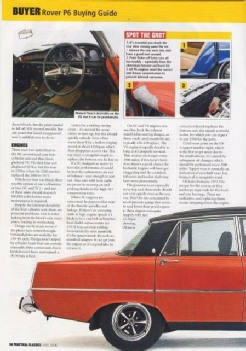
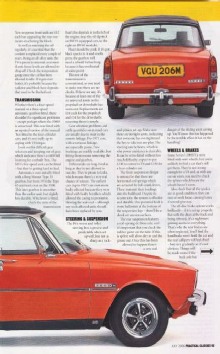
Buy a really nice P6 and you can’t go wrong; they make utterly usable everyday classics thanks to their comfort, build quality and practicality. While the V8s are thirsty for everyday use, they offer the perfect antidote to modern motoring. But you don’t need the 3500’s power and torque, because the manual 2000 and 2200 models also offer a decent turn of speed and are just as comfortable. If you’re in no hurry the automatic 2000s are okay, but they’re rather sluggish and are best kept for occasional use only. However, there are a couple of rarities worth seeking out; a VIP model with all extras and a unique interior (77 built) or one of the 200 or so estates produced by FLM Panelcraft. You could also try an export car [‘NADA’ =USA spec or ‘CKD’ = built in South Africa, New Zealand] as quite a few have found their way back to the UK. Happy hunting!
WHICH IS WHICH?
10/63: P6 breaks cover at Earls Court motor show, as the 2000, with 90bhp 1978cc four-cylinder engine.
10/66: 2000TC arrives, with new rear light units, negative earth electrics and 120mph speedo. Optional wire wheels (rarely specified) are now available and an automatic gearbox is now available on the 2000.
4/68: Rover 3500 on sale, with 160bhp Buick-derived V8 engine. Available as an auto only.
12/68: All cars now have through-flow ventilation and fixed rear quarterlights; this lasted a year before the rear quarterlights were re-instated, by popular demand.
2/70: Wire wheels no longer available on the TC.
10/70: Series II P6 shown at Paris motor show. Known as the MkII by Rover, Series II by everyone else, changes are largely cosmetic, such as black honeycomb grille, vinyl-covered C-pilla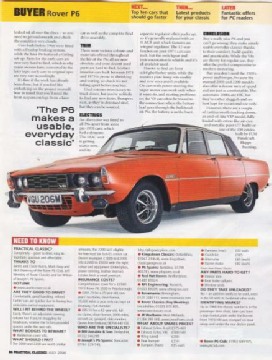 rs and the introduction of circular instruments. Strip speedo remains on the SC and automatic 4-cylinder cars until production ends.
rs and the introduction of circular instruments. Strip speedo remains on the SC and automatic 4-cylinder cars until production ends.
10/71: 3500S launched; it’s a manual-gearbox 3500 with a vinyl roof.
10/73: The 2000 engine is replaced by 2200 unit. Vinyl roof now optional on all cars.
3/77: The last P6 is built.
PRACTICAL CLASSIC?
Completely – good to drive, easy to maintain, spacious and affordable. What more do you need?
WHAT ARE THEY LIKE TO DRIVE?
Amazingly comfortable, with good handling and plenty of refinement. Earlier cars are quicker due to having less emissions control equipment.
WILL I FIT BEHIND THE WHEEL?
Easily, with space aplenty. There’s an adjustable steering column and if you’re struggling for headroom, make sure the factory-provided spacers under the seat rails have been removed...
WHAT BODGES SHOULD I LOOK FOR?
Welded on cover sills , bulkhead & wheel arches
WHAT SHOULD I PAY?
The 2000 and 2200 are worth similar amounts; the 2200 built and registered up to 1976 are now legible for free road tax . Decent examples of either are £1400 and rise to £6000 for really nice cars; equivalent prices for the V8 are £2000 and up to £10000 with the right colour and equipment (such as tinted glass, power steering, leather interior). Estates fetch a small premium. At a recent auction a fully restored and personalised VIP sold for £23,000
WHAT WILL INSURANCE COST ME?
Most classic car insurance is available with limited mileage, agreed valuation and breakdown cover for P6. Typically cover costs between £80.00 to £200.00 dependent on your area and driving history.
It does pay to shop about for insurance and if you need an Insurance Valuation for the agreed figures , contact us for an inspection appointment
WHAT ABOUT SPARES PRICES?
MGBD Parts have an extensive range of service parts and other spares available online at www.roverp6cars.com
Other companies do other items like:-
Exhaust (stainless 4-cyl) around £500 Exhaust (stainless V8) around £650 2000TC/2200TC manifolds in stainless around £500
(Prices from various suppliers)
ARE ANY PARTS HARD TO GET? 1 Interior trim 2 Rear bumpers 3 Fuel tank sender
CAN THEY COPE WITH UNLEADED? It is recommended to use an additive , even the V8 with its (supposedly hardened) valve seats, has been known to suffer valve seat recession.
WHERE ARE THE IDENTIFYING MARKS?
Up to 1968 the chassis number is in the passenger door shuts; later cars have a pop-riveted plate under the bonnet on the flitches .
From 1972 the VIN was stamped on to both inner wings and also under the rear decker panel, in front of the boot.
WHICH CLUB SHOULD I JOIN
The Rover P6 Club
P6 Rover Owners Club
The Rover Sports Register
Check out our links pages for Rover clubs outside the UK
CAPTIONS:
Interior: Luxurious interior was for captains of industry; note the manual gearbox which is very desirable
Engine bay: The V8 unit is creamy smooth, and even now is hard to beat for refinement and performance
Spot the grot:
1. It’s essential you check the rear door closing panel for rot – remove the rear seat too
2. Paint flakes off later cars all too readily – especially the aluminium bonnet and boot lid
3. All P6 engines need the correct anti-freeze concentration to prevent internal corrosion
Written by Richard Dredge [with assistance from Mark Gray], for Practical Classics, April 2006
Updated By Mark Gray MGBD Parts & Services , May 2016
 Rover P6: 1963-
Rover P6: 1963-


 rs and the introduction of circular instruments. Strip speedo remains on the SC and automatic 4-
rs and the introduction of circular instruments. Strip speedo remains on the SC and automatic 4-

